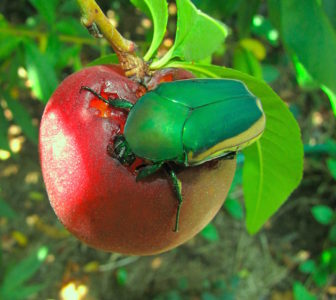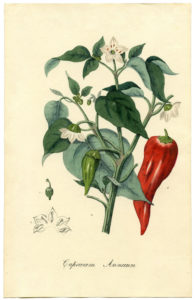The Joy of Joy
August 3, 2016
“Now I am light; now I fly; now I see myself beneath myself; now a god dances through me.”
~ Friedrich Nietzsche,
From Thus Spake Zarathustra: A Book for All and None

This morning I woke up a bit down. Not a debilitating depression, but one that causes you to awaken with a “sigh” rather than a smile.
I poured myself some iced coffee and went to sit on the porch to savor this week’s slightly milder summer temperatures. I sat, sipping my cool, strong coffee and attempted to shift my mood, but I was unsuccessful. As I turned to go back inside the house, I heard a familiar buzzing sound behind me. Even before turning around to look, I knew the source. My old friend, the California Fig Eater had returned.
The California Fig Eater (cotinis mutabilis), is a scarab beetle, native to the southwestern United States, that feeds on summer fruits like figs, peaches and plums that have fallen to the ground or are damaged. Fig eaters are bright, velvety green on their tops, while their undersides are a metallic blue green. They move through the air awkwardly, and seem to be perpetually trying to maintain their balance, almost reminiscent of single engine planes from the first years of human flight. Their low buzzing is equally awkward, sounding like a sputtering engine. The fig eater’s life cycle is the same as the fruit it is named for; they arrive in mid summer and last until late August or September.
Each season, when the fig eater returns, he always seems to arrive just when I am in need of uplifting. He buzzes by as if to say, “Remember me? In case you forgot, I am here to remind you that everything will be alright!”

The abrupt shift of my mood upon seeing my old acquaintance reminded me of my friend’s son Austin, just before his first birthday. A group of friends and I were all on a camping trip at Jalama Beach and, as his mom and I put together an outdoor dinner for the group, Austin sat on top of a picnic table, strapped into his carrier. Maybe because of the heat, or the wind blowing sand around, or his mom otherwise occupied, Austin began to cry with frustration. He sounded as if his world had come to an end. Just then, his grandmother held a peach in front of his face. Suddenly he stopped crying, broke into a huge grin and took a happy bite. Crisis averted.
I have never forgotten Austin and the peach. I was impressed with how easily he let go of whatever was worrying or frustrating him a minute before and fully immersed himself in the joy of a ripe piece of summer fruit. I couldn’t help but compare his childhood ability to live in the moment with my adult tendency to drag my mental and emotional baggage around throughout the day, weighing down multiple opportunities for my spirit and mood to take flight.
Which reminds me…
The first round-the-world flight of the Solar Impulse, a completely solar-powered aircraft, was recently completed. Like my friend, the California Fig Eater, its flight was not without bumps, but the return of the plane, powered by 17,000 solar cells located in its wings, has brought hope along with it.
Here in California, with record temperatures amid another year of drought, it’s easy to look at the empty part of our glass. But, the Solar Impulse reminds us that the Sun’s power is one that is full of potential, not only to heat us, but to cool us; not only to wear us down, but to power us up; to cause drought, but also to bring hope for healing. The Sun’s warmth initially gave life on Earth the opportunity to grow. Solar technology has the potential to save life on Earth as we work to adapt to a changing climate.
In fact, California now produces more utility-scale solar power than all the other states combined. We are the first U.S. state to get 5% of our annual utility-scale energy from the Sun. Renewable energy, including hydro power and rooftop solar, now makes up about one third of California’s electricity.
So, a day that began with dampened spirits was made joyful by visit from an old friend, the California Fig Eater, and an appreciation for the summer sun that brought him to me.
My glass is 3/4 full.
“Joy is the simplest form of gratitude.”
~ Karl Barth
~~~~~~~~~
One of the joys of summer is cooking outdoors. Add some extra fire to your next cookout with super-spicy Piri Piri Grilled Chicken. Ask your grocer for a pasture-raised chicken. Pastured chickens are raised compassionately, with the highest standards and with plenty of grass, shade and places to perch. They are slower growing than factory chickens and enjoy an environment modeled after their natural habitat.

Piri Piri Grilled Chicken
Piri Piri sauce is traditionally made with the Bird’s Eye Chile, a very hot pepper that grows in Africa. Piri Piri Chicken is a Portuguese specialty, also popular in Brazil. Serve with a cool potato salad, green salad and cold, fresh fruit. Ice cream, or another dairy dessert, will cool down taste buds after a spicy meal.
Piri Piri Marinade:
Zest of 3 lemons
Juice of 3 lemons
3/8 cup olive oil
3 crushed, dried bird’s eye chilies or other small, red chile peppers
1 & 1/2 teaspoons salt
Freshly ground black pepper
1 & 1/2 teaspoons freshly grated ginger root
7 to 8 cloves of garlic, minced
3/8 cup chopped fresh Italian parsley
2 & 1/2 lbs of your favorite chicken pieces
Combine ingredients for marinade in a glass jar.
Rinse chicken pieces and pat dry.
Place chicken pieces in a 9″ x 13″ glass or ceramic baking pan and coat thoroughly with 2/3 of the marinade. Cover chicken and refrigerate for 12 to 24 hours. Save remaining marinade in a small container and store in fridge to use for basting.
To grill:
Remove chicken and discard marinade. Place pieces on a charcoal grill over a solid be of medium coals (or over medium heat on a gas grill). If using a gas grill, close the lid. Cook, turning occasionally and basting with the reserved marinade, until skin is browned and meat is no longer pink, about 40 minutes.
Makes about 8 servings
Recent Comments